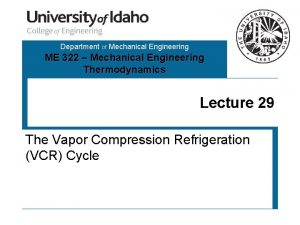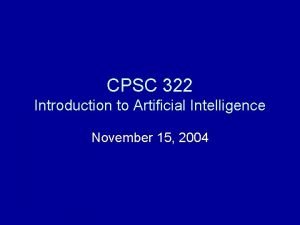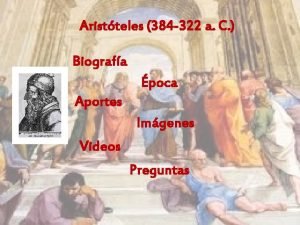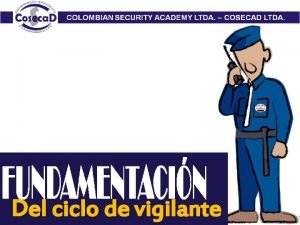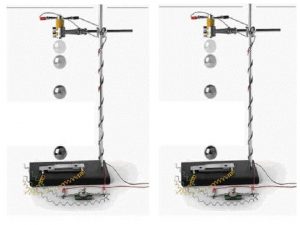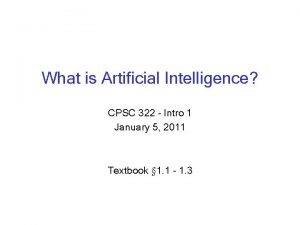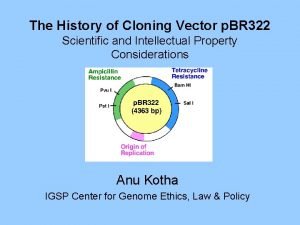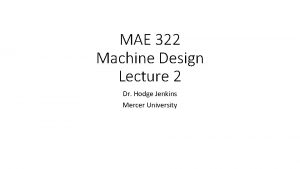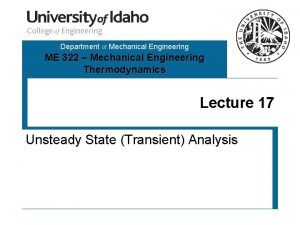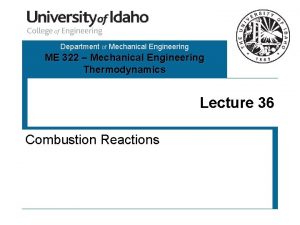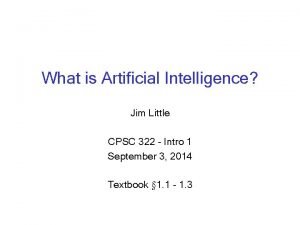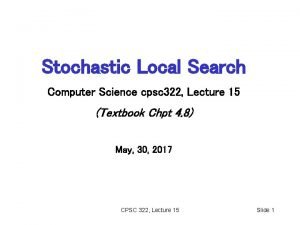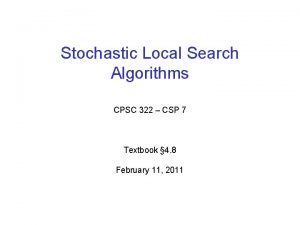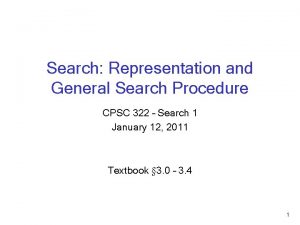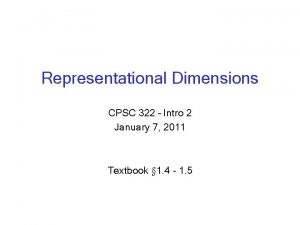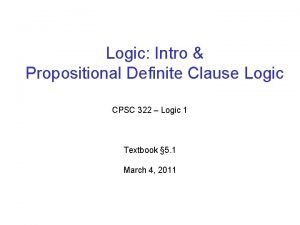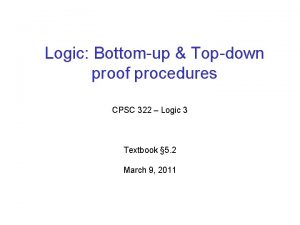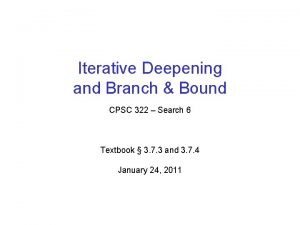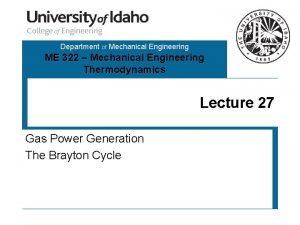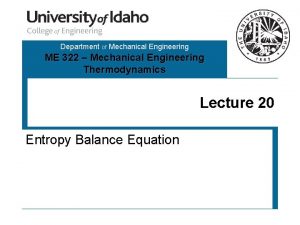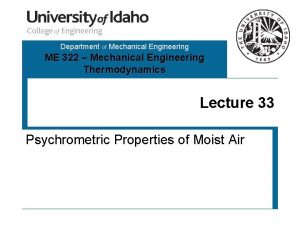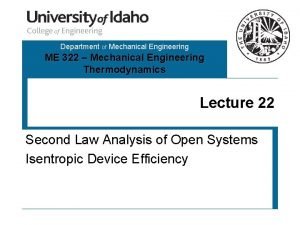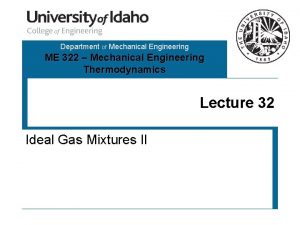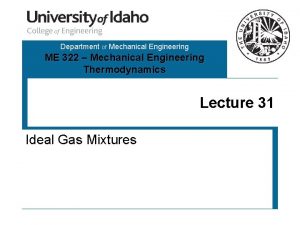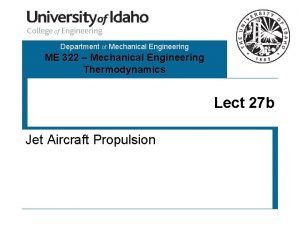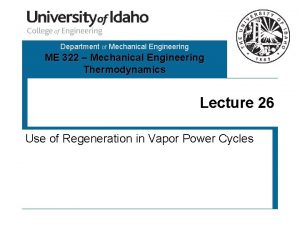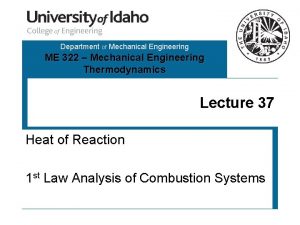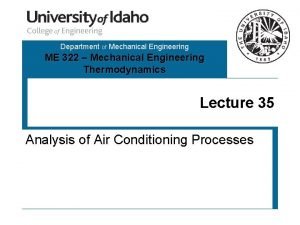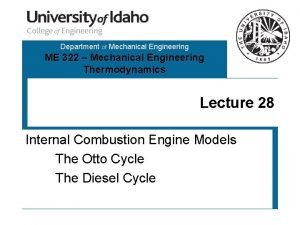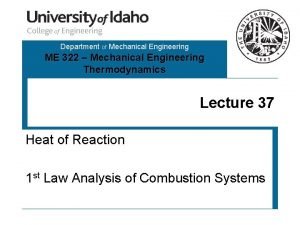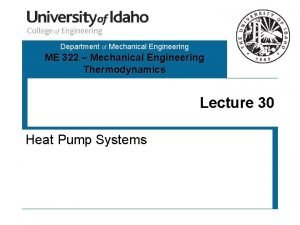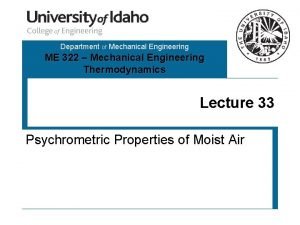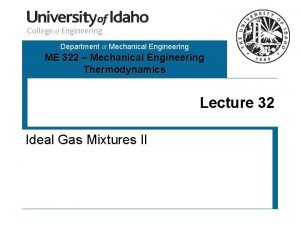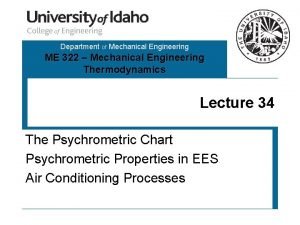Department of Mechanical Engineering ME 322 Mechanical Engineering






















- Slides: 22

Department of Mechanical Engineering ME 322 – Mechanical Engineering Thermodynamics Lecture 6 • Thermodynamic Diagrams • Phase Change • Determination of Properties with Equations of State (EOS)

Thermodynamic Diagrams The P-v-T Surface Th e. P -v Dia g ram 2 To view the T-v diagram look at the top view of the P-v-T surface m a r iag am D T iagr e. P e. D h T has P

Thermodynamic Diagrams Projections of the P-v-T 3 D surface The P-T (Phase) Diagram 3 The P-v Diagram

The State Postulate Two independent, intensive properties fix thermodynamic state of a simple substance Typical Phase Diagram This state is fixed by T and P which are independent in the single phase. Once the state is identified, all thermodynamic properties of the state are known. Defines 4

The State Postulate Two independent, intensive properties fix thermodynamic state of a simple substance Typical Phase Diagram This state on the p-T plot is unclear. What phase is the substance in? It’s right on the liquid-vapor line. Defines 5

Phase Change What is we put a sealed container with a moving piston on the stove? The other side of the piston is exposed to Start with liquid at T = 72 °F atmospheric pressure Add heat what happens? How does this look on a T-v diagram? 6

Phase Change What about other pressures? 7

T-v Diagram SC critical point G V L r po Va Saturated d te 8 ra tu Sa Liquid L+V

P-v Diagram SC critical point G L V r po Va Saturated d te 9 ra tu Sa Liquid L+V

Thermodynamic Nomenclature Phase Thermodynamic Name Liquid Compressed liquid Vapor Superheated vapor Liquid + Vapor Wet, Saturated, or 2 -Phase Mixture Gas Supercritical Saturation Property Nomenclature Saturated liquid properties are signified with a subscript f Saturated vapor properties are signified with a subscript g Saturated solid properties are signified with a subscript i For example. . . 10

Quality – A New Property p, T are NOT independent in the wet region. However, p, v and T, v are independent. But, what if you are trying to find v? To do this, I need another independent, intensive property to fix the state of a saturated mixture. The property we need is the quality, x, of the mixture. 11

Quality – A New Property Consider the total volume of a wet mixture … Define. . . Therefore. . . Substituting. . . Significance: p, x and T, x are independent, intensive properties in the wet region! 12

Quality – A New Property A little algebra. . . Quality expressions are valid for other internal energy, enthalpy, and entropy too! 13

Department of Mechanical Engineering ME 322 – Mechanical Engineering Thermodynamics Property Models The Incompressible Substance Model The Ideal Gas Model The Real Fluid Model

Department of Mechanical Engineering ME 322 – Mechanical Engineering Thermodynamics The Incompressible Substance Model Liquids and Solids

The Incompressible Substance Model As seen in the reading (Section 3. 9. 1), It can also be shown (see Section 3. 9. 1) that, If we know the value of c (or the variation of c with T), the above equation, du = cd. T can be integrated between any two states to determine the change in internal energy. Once the change in internal energy is known, the change in enthalpy can also be found! 16

Department of Mechanical Engineering ME 322 – Mechanical Engineering Thermodynamics The Ideal Gas Model Gases T >> Tc and P << Pc

The Ideal Gas Model As seen in the reading (Section 3. 9. 2), Since we are dealing with an ideal gas, pv = RT. Therefore, This leads to the following conclusion (section 3. 9. 2), It can also be shown (section 3. 9. 2) that, 18

The Ideal Gas Model Significance: These equations allow us to determine internal energy and enthalpy changes for ideal gases. In order to integrate the du and dh equations, we need to determine of the specific heats (the other can be found with the third equation). With ideal gases, the specific heat dependence on temperature may be stronger compared to incompressible substances. Exceptions: The heat capacities are constant for the inert gases. For the inert gases, cp = 5 R/2 19

Department of Mechanical Engineering ME 322 – Mechanical Engineering Thermodynamics The Real Fluid Model True for the complete P-v-T surface

The Real Fluid Model • Theoretical extension of the Ideal Gas EOS – Clausius, van der Waals, Beattie-Bridgeman, Redlich-Kwong (Section 3. 9. 4) • Theory cannot fully predict correct fluid behavior – Example: The van der Waals EOS is not valid in the liquid phase! • Modern EOSs include theoretically significant terms, but also have empirical terms to make up the deficiency in theory 21

The Modified Benedict-Webb-Rubin EOS A high-accuracy EOS 22
 Eee ankara
Eee ankara Me 322
Me 322 Ssis-322
Ssis-322 Mycin
Mycin Nació en macedonia en el 384 a. c.
Nació en macedonia en el 384 a. c. Cual es el decreto 3222 de 2002
Cual es el decreto 3222 de 2002 Fe 322
Fe 322 Aristote 384-322
Aristote 384-322 Cpsc 322: introduction to artificial intelligence
Cpsc 322: introduction to artificial intelligence Br 322
Br 322 Octahedral stress theory
Octahedral stress theory Cpsc 322: introduction to artificial intelligence
Cpsc 322: introduction to artificial intelligence Me 322
Me 322 Me 322
Me 322 Stoichiometric reaction
Stoichiometric reaction Ubc cpsc 322
Ubc cpsc 322 Cpsc 322
Cpsc 322 Cpsc 322
Cpsc 322 Cpsc 322
Cpsc 322 Cpsc 322
Cpsc 322 Definite clause logic
Definite clause logic Cpsc 322
Cpsc 322 Iterative deepening a* search
Iterative deepening a* search

